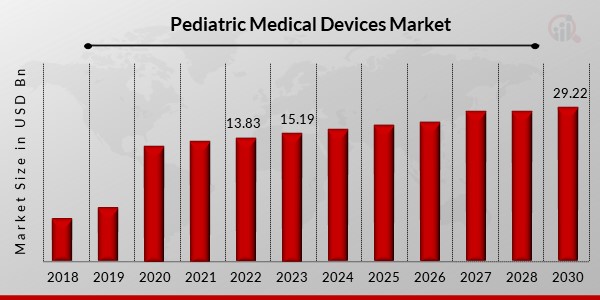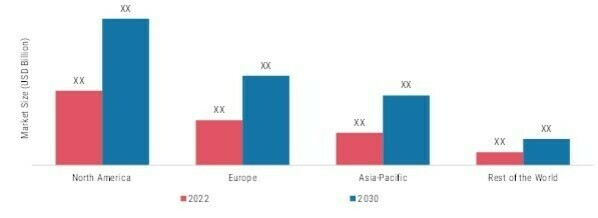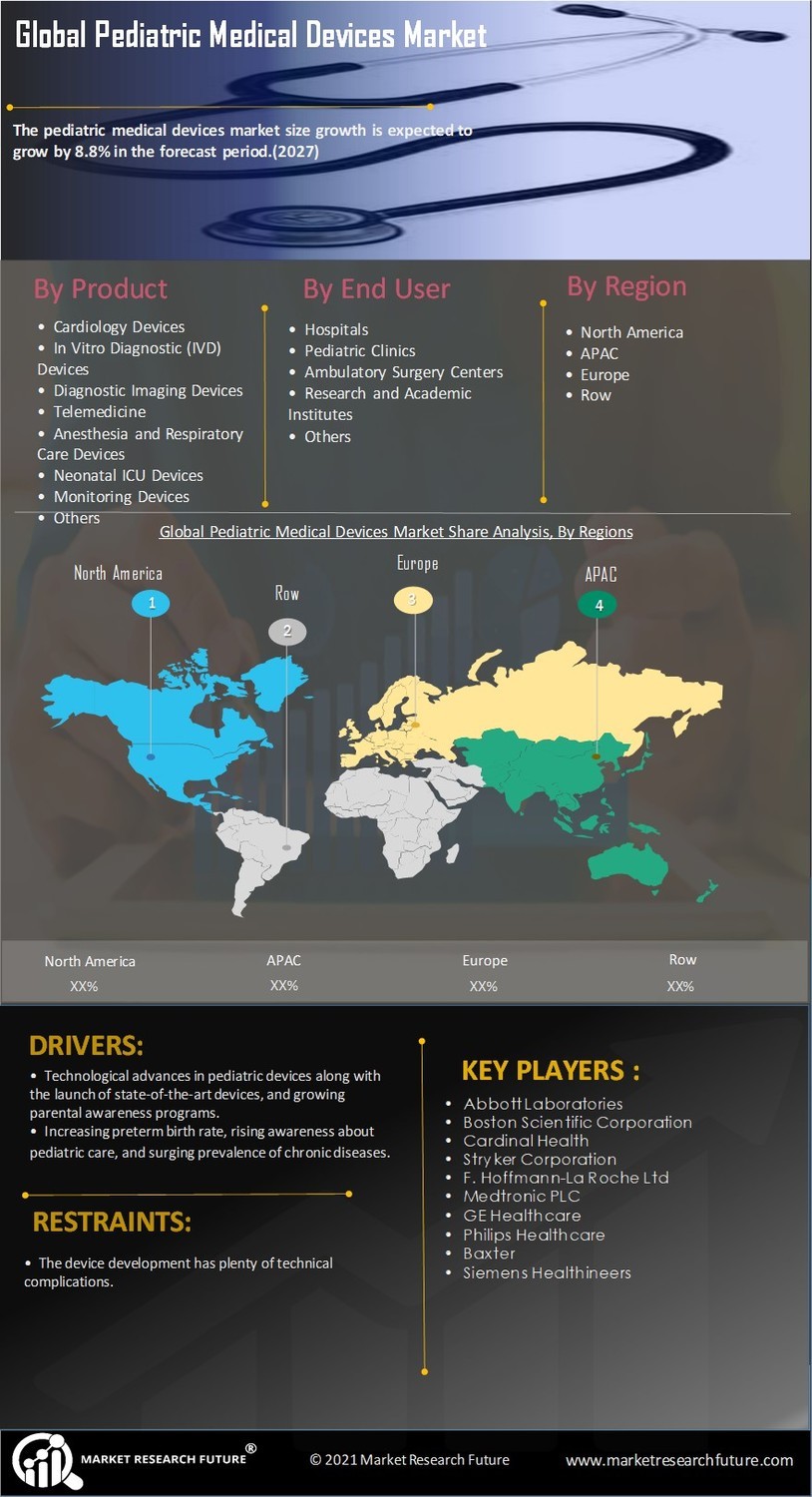Global Pediatric Medical Devices Market Overview
Pediatric medical devices market size was valued at USD 13.83 billion in 2022. The pediatric medical devices market industry is projected to grow from USD 15.19 Billion in 2023 to USD 29.22 billion by 2030, exhibiting a compound annual growth rate (CAGR) of 9.80% during the forecast period (2023 - 2030). The major factors contributing to the market growth are technological advancement in pediatric devices, increasing preterm birth rate, and rising awareness about pediatric care.
Source Secondary Research, Primary Research, MRFR Database and Analyst Review
Technological progress in pediatric equipment, a rising preterm birth rate, and increased knowledge about pediatric care are driving the market. Over the forecast period, the market is expected to rise due to the rising demand for pediatric medical devices due to the rising prevalence of chronic diseases such as respiratory disorders and asthma among children.
The government's increased spending on R&D programs and the rising demand for devices used in cardiology, the neonatal intensive care unit (ICU), and monitoring all contribute to the expansion of the pediatric medical devices market. The market for pediatric medical devices is influenced in part by the growing popularity of anesthetic and respiratory devices as a result of their success in treating conditions like asthma and the worldwide growth in premature birth rates.
In January 2023: The US Food and Drug Administration (FDA) has given Arthrex's ACL TightRope implant the green light for use in children in January 2023. According to its creators, the TightRope implant is the first and only fixation device for anterior cruciate ligament (ACL) injuries that is suitable for use in children. For over a decade, Arthrex has collaborated with top orthopaedic surgeons at HSS to refine minimally invasive approaches to ACL reconstruction in children and adolescents. Following Cordasco's and Green's recommendations, Arthrex created instrumentation instructions tailored to the needs of pediatric and adolescent patients in order to more effectively treat ACL injuries in young athletes. Surgeons can reduce the risk of permanent growth disturbance by drilling ACL sockets outside of the growth plate utilizing pediatric-specific equipment guides.
Due to the rising frequency of chronic diseases in children and adolescents and the increased attention paid to pediatric healthcare, the global market for pediatric medical devices is expanding rapidly. In addition, it is anticipated that rising requirements for pediatric medical devices and increased global R&D will fuel market expansion. Over the forecast period, the market is anticipated to rise due to the growing demand for pediatric medical devices brought on by the rising prevalence of chronic diseases in children, such as asthma and respiratory disorders. At first, the COVID-19 pandemic greatly affected the market for pediatric medical devices. Worldwide manufacturing facilities for medical device businesses have been closed due to the contagion.
Pediatric devices are medical devices or tools used to treat or diagnose illnesses and conditions in children under 21. Pediatrics is a branch of medicine focusing on the wellness and medical care of infants, children, and adolescents. Children are developed specifically with their requirements in mind because they are smaller and more energetic than adults. The shutdown delays medical equipment transportation, causing a supply crunch for several essential medical devices. The limitation on the production and distribution of medical devices was relaxed as the demand for them rose. However, difficulties with pediatric device development and a shortage of qualified personnel are anticipated to hamper the global pediatric medical devices market growth.
Most medications and medical equipment are administered to children for off-label purposes. The difficulties in producing pediatric medical devices are brought on by a shortage of patients and the small number of pediatric patients. Compared to adult studies, fewer children are enrolled in clinical trials. The need for parental agreement and approval also complicates the admission of minors to clinical trials. On the other hand, it is anticipated that a lack of substantial biocompatibility and safety standards for medical devices will restrain the market's expansion for pediatric medical devices.
With the basic guiding principle that "infants and children are not scaled-down versions of adults," Purdue University, the Indiana University School of Medicine, and the medical device business Cook Medical are focusing an innovative alliance on clinical needs in pediatrics. The Crossroads Pediatric Device Consortium is committed to addressing the unmet needs of pediatric patients by hastening the creation, endorsement, and accessibility of cutting-edge pediatric medical devices.
Pediatric Medical Devices Market Trends
- The increasing preterm birth rate to boost the market growth
Children who need NICU treatment are frequently transferred there within 24 hours of birth due to difficulties during delivery, early birth, or health problems after birth. If a child is born before 37 weeks of pregnancy, it is called preterm. According to the Centers for Disease Control and Prevention's November 2021 update, one in ten infants delivered in the United States in 2020 experienced preterm birth.
Moreover, preterm birth rates among African American women (14.4%) in 2020 were roughly 50% higher than those among white or Hispanic women, according to the aforementioned study. (9.1 percent and 9.8 percent respectively). This will probably accelerate the segment's development in the ensuing years. rising occurrence of preterm births worldwide is expected to spur market expansion over the coming years.
Pediatric Medical Devices Market Segment Insights
Pediatric Medical Devices Product Insights
The pediatric medical devices market segmentation, based on Product, includes cardiology devices, in vitro diagnostic (IVD) devices, diagnostic imaging devices, telemedicine, anesthesia & respiratory care devices, neonatal ICU devices, monitoring devices, and others. The neonatal ICU devices segment was expected to hold the majority share in 2022 in the pediatric medical devices market. This is due to an extremely high rate of complications during delivery, premature birth, or health complications following birth. Furthermore, the increasing demand for NICU is accountable for the expansion of the segment.
Figure 2 Pediatric Medical Devices Market, by Product, 2022 & 2030 (USD Billion)
Source Secondary Research, Primary Research, MRFR Database and Analyst Review
Pediatric Medical Devices End User Insights
Based on end user, the pediatric medical devices industry has been segmented into the hospitals, pediatric clinics, ambulatory surgical centers, research and academic institutes, and others. The hospitals and clinics segment were accounted for the largest market share in 2022, owing to the rise in the number of government and private hospitals in emerging countries such as China and India along with an increase in the adoption of pediatric care equipment in hospitals. According to a study released in the National Library of Medicine, over 2 million children are admitted to hospitals in the United States each year, accounting for 40% of all costs associated with pediatric healthcare. Furthermore, rising demand for advanced medical devices for better medical care are expected to propel the segment’s growths.
July 2021 Abbott (US) launched pea-sized life-saving device for babies with hole in heart. The device is particularly useful for tiny babies who may not be able to undergo surgery to repair their hearts.
February 2023: Brain Scientific, an applied science technology firm based in Florida, has secured a sizable order for NeuroCaps from MVAP Medical Supplies, the firm announced on its website on February 2023. NeuroCap's combination of power and usability makes it ideal for pediatric neurodiagnostic use, which in turn improves care for all patients. In order to strengthen its position as the market leader in the rapidly developing medical wearables industry, Brain Scientific has partnered with MVAP Medical Supplies, a market leader in the sleep, EEG, EMG, IOM, respiratory, and patient care supplies space.
June 2023: To speed up the development of the NIVA Pediatric Monitor, a device intended to provide volume status monitoring non-invasively for pediatric patients, VoluMetrix, a Nashville-based biotech startup dedicated to creating a new wave of solutions for vital monitoring to enhance well-being, has been awarded a grant from the Pennsylvania Pediatric Medical Device Consortium, funded by the U.S. Food and Drug Administration. However, changes in vital signs often occur after major blood loss and end-organ damage have already established, making it difficult to detect hemorrhage in children at an early stage. VoluMetrix's NIVA Pediatric Monitor is an investigational non-invasive sensor patch worn on the wrist, and it aims to fill this important gap in care. This cutting-edge tool can be used during surgery and the subsequent recovery period to assess volume and detect bleeding in real time.
Pediatric Medical Devices Regional Insights
By Region, the study segments the market into North America, Europe, Asia-Pacific, and Rest of the World. North America pediatric medical devices market was accounted for the largest market share in 2022, due to presence of key players, high prevalence of pediatric chronic diseases in the region, established healthcare infrastructure, and launch of new products. In addition, according to a study released in October 2021 by the Centers for Disease Control and Prevention (CDC), more than 40% of school-aged children and teenagers in the United States have at least one chronic health condition, such as asthma, obesity, other physical diseases, and behavior/learning problems. Therefore, pediatric medical devices are created in order to offer better care, which will have a big effect on the market.
Further, the major countries studied are The US, Canada, Germany, France, UK, Italy, Spain, China, Japan, India, Australia, South Korea, and Brazil.
Figure 3 PEDIATRIC MEDICAL DEVICES MARKET BY REGION 2022 & 2030
Source Secondary Research, Primary Research, MRFR Database and Analyst Review
Europe pediatric medical devices market accounted for the second-largest market share in 2022. This is due to the increasing demand for medical devices, growing research, and development in the field of medical technology, rising numbers of hospitals that are dedicated pediatric facilities.in the region. Additionally, a sizable patient base with low birth weight and an uptick in preterm deliveries are expected to drive market expansion in Europe. Furthermore, the Germany pediatric medical devices market was attributed to hold the largest market share, and the UK pediatric medical devices market is estimated to be the fastest growing market in the Europe region. Furthermore, growing parental awareness programs and increase in investment in research and development activities is driving the France pediatric medical devices market.
The Asia-Pacific pediatric medical devices market is expected to grow at a significant share from 2023 to 2030. This is due to increasing initiatives by private and government agencies, rising awareness programs for newborn care, and increasing birth rates in the Asia-Pacific region. Moreover, China pediatric medical devices market attributed to hold the largest market share in 2022 and is estimated to be the fastest growing market in the Asia-Pacific region.
Pediatric Medical Devices Key Market Players & Competitive Insights
Major market players are spending a lot of money on R&D to increase their product lines, which will help the pediatric medical devices market grow even more. Market participants are also taking a range of strategic initiatives to grow their worldwide footprint, including new product launches, contractual agreements, mergers and acquisitions, increased investments, and collaboration with other organizations. Competitors in the pediatric medical devices industry must offer cost-effective items to expand and survive in an increasingly competitive and rising market environment.
Abbott Laboratories (Abbott) discovers, develops, manufactures, and sells healthcare products across the globe. The company operates through four reportable segments, namely, established pharmaceutical products, diagnostic products, nutritional products, and vascular products. The established pharmaceutical products segment offers a broad range of branded & generic pharmaceutical products. The nutritional products segment sells & distributes adult and pediatric nutritional products. Diagnostic products segments offer diagnostic tests & instruments for blood banks, hospitals, and commercial laboratories. The medical devices segment offers devices for a range of treatment including cardiac arrhythmias & heart failure, vascular, neuromodulation, structural heart, and diabetes care. Abbott sells its products to customers in more than 160 countries. For instance, in June 2021, Abbott (US) launched Amplatzer Piccolo Occluder in India, the world's first medical device that can be implanted in the tiniest babies (weighing as little as 700 gms) using a minimally invasive procedure to treat patent ductus arteriosus, or PDA.
Also, Boston Scientific Corporation is a worldwide developer, manufacturer, and marketer of medical devices used in various interventional medical specialties. Its product portfolio is majorly divided into six business divisions endoscopy, interventional cardiology, neuromodulation, peripheral interventions, rhythm management, and urology & pelvic health. Boston Scientific Corporation's manufacturing facilities are located across Malaysia, the US, and Ireland. Apart from this, it has a presence in Japan, Netherlands, France, Poland, India, China, Turkey, South Africa, and Singapore.
Key Companies in the Pediatric Medical Devices Market includes.
- Abbott (US)
- Boston Scientific Corporation (US)
- Medtronic PLC (Ireland)
- Cardinal Health, Inc (US)
- Hoffmann-La Roche Ltd. (Switzerland)
- GE Healthcare (US)
- Koninklijke Philips N.V. (Netherlands)
- Baxter International, Inc (US)
- Siemens Healthineers (Germany)
- Stryker (US)
Pediatric Medical Devices Industry Developments
December 2020 Medtronic PLC (Ireland) launched the First and Only Pediatric and Neonatal Acute Dialysis Machine in the U.S. The Carpediem system is designed to treat patients requiring renal replacement therapy weighing between 2.5 and 10 kilograms (5.5 to 22 pounds).
May 2021 Medtronic PLC (Ireland) launched New Pediatric Monitor That Alerts Clinicians To Potential Airway Obstructions During Ventilation. the SonarMed airway monitoring system utilizes acoustic technology to check for endotracheal tube (ETT) obstruction and verify position in real-time, giving clinicians vital information required to make more informed, life-saving decisions for their smallest patients.
September 2022 Stryker (US) launched Q Guidance System with Spine Guidance Software. The System combines new optical tracking options provided by a redesigned, state-of-the-art camera with sophisticated algorithms of the newly launched Spine Guidance Software to deliver more surgical planning and navigation capability than ever before.
Pediatric Medical Devices Market Segmentation
Pediatric Medical Devices Product Outlook
- Cardiology Devices
- In Vitro Diagnostic (IVD) Devices
- Diagnostic Imaging Devices
- Telemedicine
- Anesthesia & Respiratory Care Devices
- Neonatal ICU Devices
- Monitoring Devices
- Others
Pediatric Medical Devices End User Outlook
- Hospitals
- Pediatric Clinics
- Ambulatory Surgical Centers
- Research and Academic Institutes
- Others
Pediatric Medical Devices Regional Outlook
-
North America
-
Europe
- Germany
- France
- UK
- Italy
- Spain
- Rest of Europe
-
Asia-Pacific
- China
- Japan
- India
- South Korea
- Australia
- Rest of Asia-Pacific
-
Rest of the World
- Middle East
- Africa
- Latin America
Pediatric Medical Devices Report Scope
| Report Attribute/Metric |
Details |
| Market Size 2022 |
USD 13.83 billion |
| Market Size 2023 |
USD 15.19 billion |
| Market Size 2030 |
USD 29.22 billion |
| Compound Annual Growth Rate (CAGR) |
9.80% (2023-2030) |
| Base Year |
2022 |
| Forecast Period |
2023-2030 |
| Historical Data |
2019 & 2020 |
| Forecast Units |
Value (USD Billion) |
| Report Coverage |
Revenue Forecast, Competitive Landscape, Growth Factors, and Trends |
| Segments Covered |
Product, End User, and Region |
| Geographies Covered |
North America, Europe, Asia Pacific, and Rest of the World |
| Countries Covered |
The US, Canada, Germany, France, UK, Italy, Spain, China, Japan, India, Australia, South Korea, and Brazil |
| Key Companies Profiled |
Abbott (US), Boston Scientific Corporationv(US), Medtronic PLC (Ireland), Cardinal Health, Inc (US), F. Hoffmann-La Roche Ltd. (Switzerland), GE Healthcare (US), Koninklijke Philips N.V. (Netherlands), Baxter International, Inc (US), Siemens Healthineers (Germany), and Stryker (US) |
| Key Market Opportunities |
Innovation in medical devices and awareness programs |
| Key Market Drivers |
Technological advancement in pediatric devices Increasing preterm birth rate Rising awareness about pediatric care |
Pediatric Medical Device Market Highlights:
Frequently Asked Questions (FAQ) :
The pediatric medical devices market is anticipated to reach 29.22 billion in 2030, at a CAGR of 9.80% during the forecast period of 2023-2030.
The US is expected to hold a 35-40% share of the North America market for pediatric medical devices market during the forecast period of 2023-2030.
The pediatric medical devices market is expected to grow at a 9.80% CAGR during the forecast period from 2023 to 2030.
The North America region market held the largest market share in the Pediatric Medical Devices Market.
The key players include Abbott (US), Boston Scientific Corporationv(US), Medtronic PLC (Ireland), Cardinal Health, Inc (US), F. Hoffmann-La Roche Ltd. (Switzerland), GE Healthcare (US), Koninklijke Philips N.V. (Netherlands), Baxter International, Inc (US), Siemens Healthineers (Germany), and Stryker (US).
The neonatal ICU devices segment was estimated to lead the pediatric medical devices market.
The hospitals segment is attributed to having the largest market share based on end users.





























